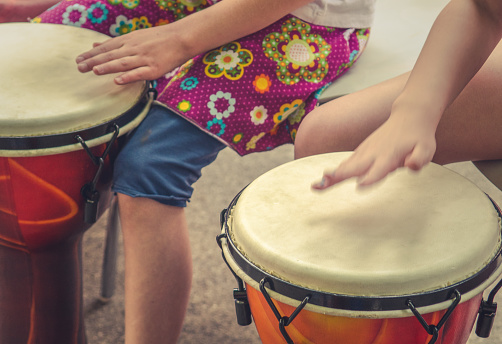As every baby who's ever beaten a spoon against her high chair knows, there's nothing more fun than the rhythm of a pounding drum sound. Fast or slow, loud or soft, people around the world use the drum to build community spirit.
In Africa, legend says the story drum was created long ago in a time of hardship to help the people celebrate and remember what was good about their lives as they tell their stories to its rhythms. Japan's esteemed Noh and Kabuki theaters use a drum called the taiko and other traditional instruments to create sound effects as the actors perform stories from the past. A drum is also used in sumo wrestling matches to get the audience's attention as the competition begins and during festivals. Native Americans share their heritage with drum music at powwows. The drum rhythms, often accompanied by ancient song, provide an essential part of the performance. Their music tells the stories of victories won and legends of their gods.
If you visit Colonial Williamsburg, you may see a parade of the military fife and drum. Drummers with the Colonial army were as young as ten years old. Their snare drums provided music for the army's march, and the drum beats carried a commander's orders far across the field to his troops.
You can make a simple drum just by turning over a metal bowl and hitting it. Try banging on it with a metal spoon. Then, try a wooden spoon to see how different the sound is. If your parents happen to have stackable bowls in sizes from small to large (and they say it's okay!), hear the different sounds the bowls make when you strike them. A drum is a percussion instrument, meaning that you beat it to make the sound. Other percussion instruments are the xylophone, the hammered dulcimer, the marimba, and the piano. Sometimes, drummers will use brushes on their drums to create swishing sounds, hard like rain or soft like snow, depending on what they use. Many times, cymbals are played alongside drums to add more excitement to the music.
Check out these children nonfiction and fiction titles about the legend of the drum.
On the Web
Homemade Percussion & Junkmusic
You might want to skip the fishskin drum, but there are many useful and creative ideas here for percussion instruments: coffee can drums, tube drums, and metal bowls as well as a homemade xylophone and Surdo (Brazilian bass drum) mallets.
Super Sounding Drums
Zoom! This site from PBS tells how to make an impressive-sounding drum with a few simple materials available around the house and at a hardware store.

